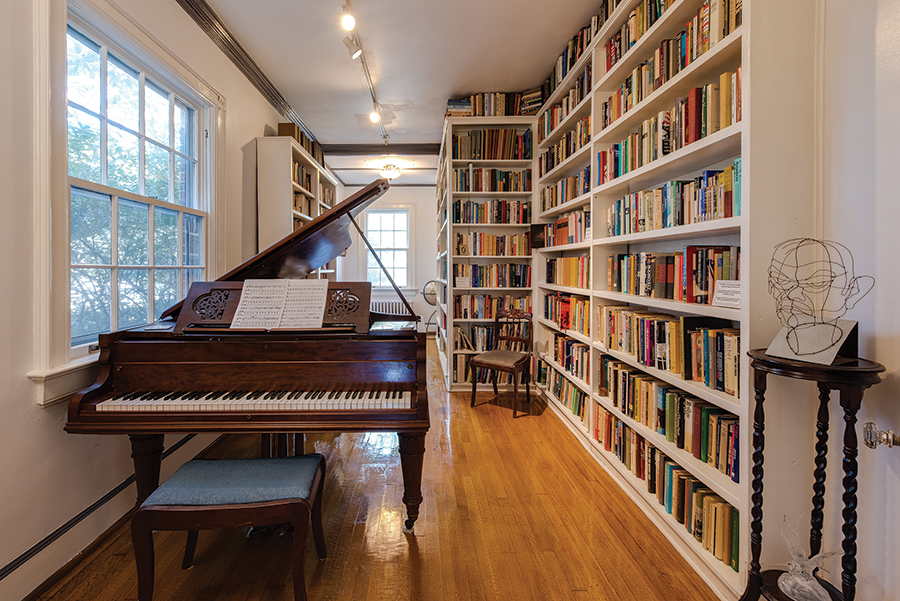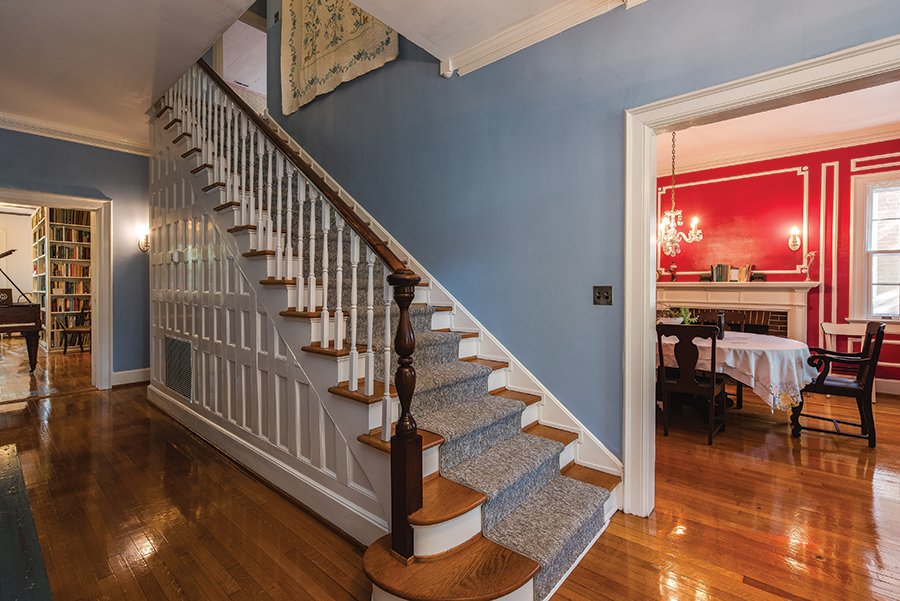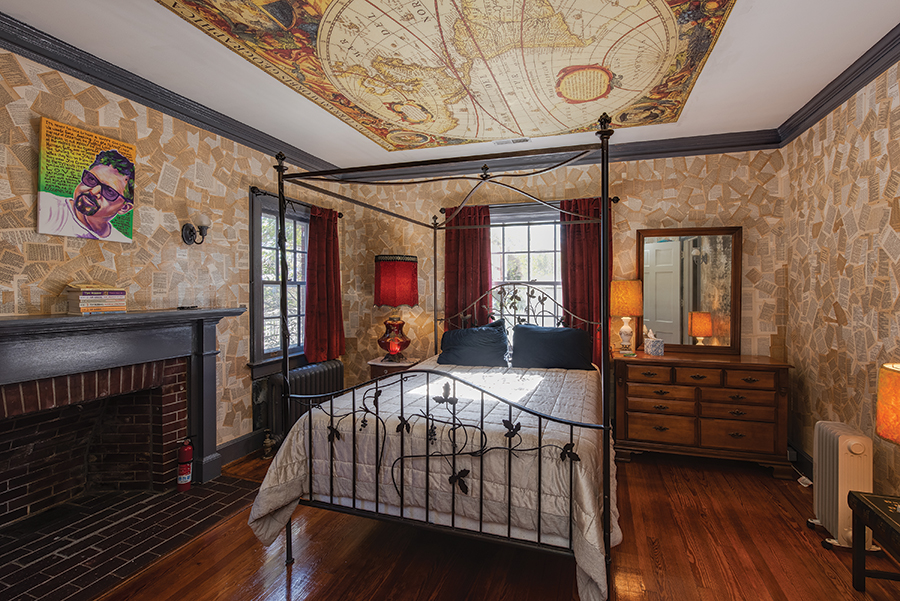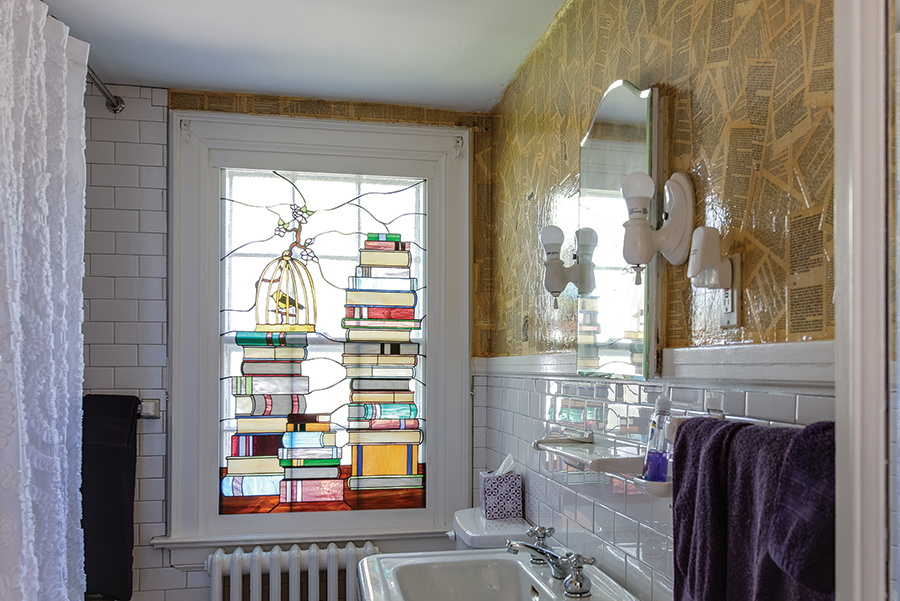Between the Covers
You can go home again. Ask Gwenyfar Rohler, who has transformed her childhood home into a literary North Carolina-themed bed-and-breakfast
By Gwenyfar Rohler • Photographs by Rick Ricozzi
“My mother won the battle about the dining room paint color from beyond the grave. It’s true. She had been dead for nine years and she still won.” When I say that to people, they tend to give me a patronizing look. But I am here to tell you that the mother/daughter power struggle doesn’t end at the grave. The dining room was my mother’s place to show off. Holidays and dinner parties: This was her grand stage, and she dressed it with an Empire mahogany dining set that could pull out to seat 18, china, crystal and Oriental rugs. It was the last interior room I had to finish before we opened my childhood home to the public as Between the Covers, a N.C. literary bed-and-breakfast.

I had spent three years ruminating on paint colors for the dining room to try to save it from this Spanish bordello look that my mother affected. When I was little, it was a mauve/puce color that my father finally rebelled against in the early 2000s: “Diana, I cannot eat another Thanksgiving dinner in a room that looks like Pepto-Bismol!” he said. So my mother had it painted a deep wine color. I hated it. But I put off repainting it because I was intimidated to paint all the wedding-cake molding. On the morning that Elise Seifert, my steady right hand in the renovation and decoration process, and I were putting paint and wallpaper samples on the wall, the air conditioner died downstairs. The estimate came back at close to $8,000 — money I didn’t have and would have to find somewhere. All the budget for the dining room and the mental energy for it evaporated into the air- conditioner bill. Fine. I’ll repaint it the same color. Everyone else seems to like it anyway. You win, Mommy.
“Scarlett O’Hara and Tara are like child’s play compared to how I feel about this house,” I frequently tell people. We met on a spring day in 1987, and at once I knew three things: It was haunted, it had a secret passage, and it was the most magical place I had even set foot inside in real life. It was my home and it was waiting for me. The overgrown garden was straight out of Sleeping Beauty or the Secret Garden, and the big rambling brick house with crescent-moon shutters and quarter-pie windows was obviously the setting of every Victorian story I had ever encountered. Although at 7 I had no idea that 25 years later I would walk into the planning office and apply for a bed-and-breakfast permit in order to keep my house, I already instinctively knew that we were linked for life and I would go to extraordinary lengths to protect that bond.

My parents saw the house differently, of course. They saw a brick house that would survive a hurricane. It was located six blocks from the house we were moving out of, which my paternal grandparents would shortly occupy until the end of both their natural lives. It offered a big fenced-in yard for their small child and dog to run around together in safety. It boasted a dining room grand enough to accommodate my mother’s dining set. But most important: The house had enough blank walls to build bookshelves for the family library my father devoted his life to curating.
My father grew up in a house with one book in it: the Bible. He had a paper route and one of his customers, a local university professor, had a home library that fascinated my dad. The man lent him a copy of Thomas Wolfe’s Look Homeward, Angel. The gesture changed Daddy’s life. He decided that one day he, too, would have a home library. It became one of his driving passions. Thankfully, he married a woman who shared his love of learning, language and books. So when he would come home from Mr. Daughtry’s bookstore downtown, with his arms loaded and his eyes barely peeking over the top of the stack, Mommy just smiled.

I didn’t know it at the time, but it had become apparent that my grandparents could no longer live alone in Florida, 11 hours from their closest relative. Once my parents decided to move them to Wilmington, we began house-hunting for the solution to this new phase of family life. Finding bookshelf space was the unexpected challenge. I remember real estate agents pointing to the wall of a garage as the solution to the bookshelf question.
“You really don’t understand,” Mommy shook her head. “We are not talking about two kit shelves from K-Mart. Think floor-to-ceiling built-ins.” In the car she would mutter about humidity and mold and who would treat books like that? Not to mention that most certainly there was not enough room.
When we met, my house already had glass-fronted, built-in bookcases in the living room — and the family was even leaving them filled with books that they were not taking with them! “Lloyd, we are not getting a mortgage based upon a couple hundred dollars’ worth of books you can probably buy from Mr. Daughtry,” my mother warned. But to my father it was a sign. The house came with books! This was it! Thus, I grew up with an encyclopedia set discovered in the house that was printed at the end of the 19th century: before the atomic age, before World Wars I and II, and the mythology section included 30 pages of illustrated stories.

We became the second family to live in the house. It was built by the Hoopers, and since we have owned it for more than 30 years, if we ever pursued a plaque from the Historic Wilmington Foundation, it would be designated The Hooper-Rohler House. The matriarch of the family, Mrs. Hooper, lived out the end of her days in her bedroom at the top of the stairs with servants and nurses to care for her. The rest of the house was ignored, painted a horrid institutional green and slowly decayed around her. Historic houses require constant daily care. It can feel like you hemorrhage money because everything has to be custom made for the house: None of the windows are truly square, none of the doors are standard or pre-hung, when plumbing breaks it has to be rebuilt in ways that boggle the mind. As a child I absorbed these lessons by osmosis. As an adult I have lived them. Every day for the last five years I have spent covered in paint and plaster.
My parents were not handy by any stretch of the imagination. To my father, a screwdriver was a breakfast drink, not something found in a toolbox. So the image you might have of the scrappy young couple with ideas and sweat equity restoring an old house doesn’t really fit them. How they took on the 17-year renovation project of the house amazes me still.
But they did.
They closed on the purchase of the house in the height of the summer heat, walked out of the lawyer’s office, and drove to Cannon Heating and Air, where they signed a contract to put air conditioning in the house for the first time. There is a very special smell to un-air-conditioned old houses in the South in the summer. It smells like stepping back in time. The rare whiffs I get take me immediately to that first summer before we moved in when we visited every day and watched the plaster guy re-sculpt the walls. I dubbed him Michelangelo when I saw him working on the scaffolding to reach the 14-foot ceilings downstairs. He chuckled and told me his real name, which I don’t remember.
When I hit on the idea of the B&B as a way to keep the house, I knew it would have to be themed around books and writers. In addition to our family library, we were selected by Mr. Daughtry to carry on his bookstore on Front Street when he retired. (So fate intervened, and I am now the managing partner of Old Books on Front Street! Come by and see me sometime.) The more I thought about it, the more apparent it became to me that I wanted to celebrate North Carolina writers. Not that Jane Austen and Harry Potter wouldn’t have more commercial value. But my heart, the house’s heart, and our family life was centered around the written word, and North Carolina life and culture. The dining room mantelpiece holds the books my father wrote. My grandmother had a sixth-grade education and learned English when she started grade school. The great marvel of her life was that her son got a Ph.D. and wrote books. The Hoopers were kin to William Hooper, one of the signers of the Declaration of Independence, and Johnson Jones Hooper, a Southern humorist from the early 19th century. But which North Carolina writers to choose? And how?
I knew from the very beginning that Maya Angelou — who lived in Winston-Salem and taught at Wake Forest for more than 30 years — was one of the writers I wanted to honor. At the top of the stairs is an elegant room with French doors. Originally it was probably a sleeping porch that got enclosed, maybe sometime in the 1940s or ’50s. When I was little, it was my mother’s office and occasional guest room. But now it is painted yellow in honor of Dr. Angelou’s “little yellow house that Caged Bird bought” in Winston-Salem. The west-facing windows catch the late afternoon sun and make the walls glow. It is a cozy little haven for writing that calls to me on cool winter afternoons.
The day that Elsie and I put the world map mural on the ceiling of the Tom Robbins Room is one that I will never forget. It began with me looking at her and asking if she was in until we were finished. Because wallpaper shrinks when it dries, we had to do the whole thing in one day. She grinned and agreed. “How many books are on the walls?” is the question I get asked most often by friends and guests. There are six in the two bottom layers and the top layer are both Tom Robbins novels: Another Road Side Attraction and Still Life with Woodpecker. It took six weeks to decoupage all four walls while I listened to British mystery books on tape. This was my bedroom growing up. When we first moved into the house, we all lived in this room because it was the only one that had the plaster repaired, the walls painted and the floor finished. My parents slept on a fold-out sofa and I was on a roll-away cot for six months until they moved into the room that joins via the bathroom. Now the Zelda Fitzgerald Lounge, it was my parents’ bedroom until I was about 11, when they finally moved into the master bedroom (which I plan to open as the Ender’s Game Room next year. But I need six months off from sanding plaster before I tackle that room.)
I eventually claimed the adjoining room as an office space in high school (teenagers are very interested in expanding their domain.) Somehow this was the only room to escape the institutional green treatment and still has its original wallpaper from the 1940s — which was the time period Zelda lived in Asheville. I took the radiator cover to Steven’s Hardware on Dawson and got them to match the paint color exactly for repainting the trim.
Dr. Hooper had his office in the house, and that is the first room my father lined with floor-to-ceiling bookshelves. We were still sleeping in one room and eating dinner out of cardboard boxes, but Daddy got his bookshelves. During his lifetime it was the classic university professor’s home office: two desks, overflowing file cabinets, books, stacks of papers to grade, filing cards for his current research project, articles to review . . . in short it was cozy, academic chaos. After he passed away in 2014 and I began repairing the plaster (again) and painting the walls and shelves, the rugs came up and the desks went to other rooms because local piano virtuoso James Jarvis informed me that the grand piano of my dreams was going to be delivered to the house. “It is the same vintage as the house,” James explained. “It’s perfect, it is where it belongs. (the piano) will be happy here.”
“You’ve built a temple to the written word,” one friend observed.
“No,” I shook my head thinking about the library in the house and the bookstore — the legacy from my parents. “It has built me.”
Between the Covers, A North Carolina Writers B & B, 1817 Market Street, Wilmington. (910)398-7753. For more information: betweenthecoversbandbnc.com. Visit Gwenyfar at her shop, Old Books on Front Street, 249 N. Front St., Wilmington.
Gwenyfar Rohler spends her days managing her family’s bookstore on Front Street.


